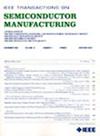Transfer Learning-Based Defect Detection System on Wafer Surfaces
IF 2.3
3区 工程技术
Q2 ENGINEERING, ELECTRICAL & ELECTRONIC
引用次数: 0
Abstract
This study addresses the significant decline in the accuracy of wafer inspection models when the imaging system changes post-training. We propose a domain adaptation method based on semantic segmentation models that maintains accuracy without the need for re-labeling data despite changes in the imaging system. This method was tested on wafers from an actual production line under two different detection environments: a custom-built simple optical system (source domain) and a precision measurement platform (target domain). To align the source and target domain datasets, we introduced an image preprocessing method that adjusts the contrast and brightness of the source domain data based on the histogram distribution of the target domain. We utilized adversarial learning to transfer features from the source to the target domain and modified the segmentation network architecture to prevent overfitting to the source domain data. Additionally, we extended the domain adaptation framework to handle multiple target domains using a multi-discriminator network strategy, enhancing the model’s adaptability to diverse production line environments. Our results demonstrate that compared to the original network, our model significantly improves accuracy with increases of 4.3%, 16.3%, and 11.4% for three different depths of the semantic segmentation model. Furthermore, our proposed network outperforms widely used style transfer methods with performance improvements of 13.2% and 17.3%. Post-processing the output segmentation maps yielded accuracy, precision, and recall scores of 96.8%, 93.5%, and 100%, respectively.基于迁移学习的晶圆表面缺陷检测系统
本研究解决了当成像系统在训练后改变时,晶圆检测模型的准确性显著下降的问题。我们提出了一种基于语义分割模型的领域自适应方法,该方法可以在成像系统发生变化时保持数据的准确性,而无需重新标记数据。该方法在实际生产线的晶圆上进行了两种不同的检测环境下的测试:定制的简单光学系统(源域)和精密测量平台(目标域)。为了实现源域和目标域数据集的对齐,我们引入了一种基于目标域直方图分布调整源域数据对比度和亮度的图像预处理方法。我们利用对抗性学习将特征从源域转移到目标域,并修改分割网络架构以防止对源域数据的过拟合。此外,我们扩展了领域自适应框架,使用多鉴别器网络策略处理多个目标领域,增强了模型对不同生产线环境的适应性。我们的结果表明,与原始网络相比,我们的模型在三种不同深度的语义分割模型上的准确率分别提高了4.3%、16.3%和11.4%。此外,我们提出的网络比广泛使用的风格迁移方法的性能提高了13.2%和17.3%。对输出的分割图进行后处理后,准确率、精密度和召回率分别达到96.8%、93.5%和100%。
本文章由计算机程序翻译,如有差异,请以英文原文为准。
求助全文
约1分钟内获得全文
求助全文
来源期刊

IEEE Transactions on Semiconductor Manufacturing
工程技术-工程:电子与电气
CiteScore
5.20
自引率
11.10%
发文量
101
审稿时长
3.3 months
期刊介绍:
The IEEE Transactions on Semiconductor Manufacturing addresses the challenging problems of manufacturing complex microelectronic components, especially very large scale integrated circuits (VLSI). Manufacturing these products requires precision micropatterning, precise control of materials properties, ultraclean work environments, and complex interactions of chemical, physical, electrical and mechanical processes.
 求助内容:
求助内容: 应助结果提醒方式:
应助结果提醒方式:


